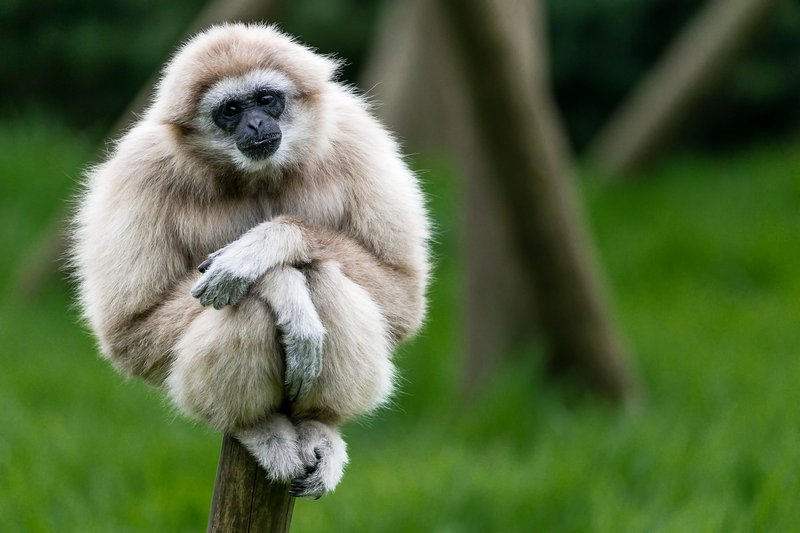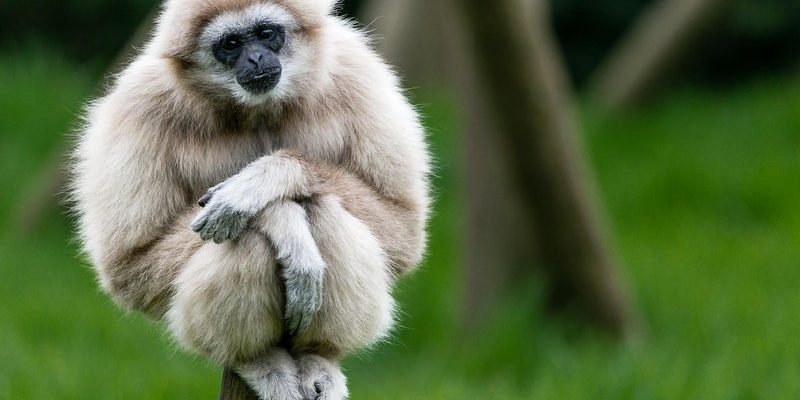
Imagine gibbons as the gymnasts of the animal kingdom. With their long arms and incredible agility, they can swing through the trees with remarkable speed and grace. They live in small family groups and have a social structure that’s both interesting and complex. If you’ve ever imagined what it would be like to live life among the leaves, let me spill some fascinating facts about these amazing primates. You might be surprised at what you learn!
1. Gibbons Are Not Monkeys!
You might be thinking, “Aren’t gibbons just monkeys?” Not quite! Gibbons belong to a group called apes, which makes them more closely related to humans, chimpanzees, and orangutans than to monkeys. Here’s the thing: apes, including gibbons, don’t have tails, which is one of the main differences that sets them apart.
Just picture this: while many monkeys use their tails for balance as they swing from branch to branch, gibbons rely on their strong arms and legs. They can leap up to 30 feet through the air, covering vast distances in a single swing! So, while they share a habitat with monkeys, they definitely march to their own beat—literally.
2. Incredible Swingers of the Forest
If you ever catch a glimpse of a gibbon in action, you’ll be amazed at their swinging skills. They have this unique mode of locomotion called “brachiation.” It’s like their version of parkour, where they use their long arms to grab branches and swing through the trees.
Imagine doing a high-flying routine on the monkey bars at the playground but at super speed! Gibbons can move through the canopy quickly, covering about 1 mile per hour while swinging. This ability helps them escape predators and find food in their lush forest homes.
3. Unique Vocalists of the Jungle
Gibbons are known for their beautiful and loud songs. Each species has a distinct call that serves multiple purposes. They sing to *mark their territory*, attract mates, and maintain social bonds within their family groups. Their calls can carry over distances of up to 2 miles, which is pretty impressive considering the dense forest environment!
Imagine standing in the jungle and hearing a chorus of gibbons harmonizing—it’s like nature’s own concert! Their vocalizations help them communicate with one another vividly, strengthening those family ties that are so important for their survival.
4. Gibbons Are Monogamous
Unlike many primates, gibbons are monogamous, meaning they usually mate for life. They form strong pair bonds, and you’ll often see them swinging through the trees together, hand in hand, or grooming one another. It’s a partnership that benefits them socially and ensures that they raise their young effectively.
You might wonder why this matters. In the wild, having a supportive partner can make a big difference. Raising a baby gibbon is no easy task, and having a companion helps both parents share the responsibility of caring for their offspring, thus improving the chances of survival for the next generation.
5. They Have Long Arms for a Reason
Gibbons sport some of the longest arms relative to body size among primates. This adaptation is essential for their lifestyle. Their lengthy limbs allow them to reach and grasp branches more effectively during their impressive swings.
To put it simply, imagine using a long-handled tool to reach something high up; that’s how gibbons navigate their arboreal world. This physical trait not only helps them move through the trees with ease but also aids them in accessing fruit and leaves—their main sources of food.
6. Diverse Diet of Fruits and Leaves
Speaking of food, gibbons primarily eat ripe fruits, but they don’t stop there! Their diet also includes leaves, flowers, and sometimes even insects. They have a taste for variety, which is essential for their survival in the wild.
Since they spend most of their lives in trees, gibbons have to be selective about their meals, choosing foods that provide the necessary nutrients. The challenge of finding ripe fruit among the foliage requires keen observation and agility, and gibbons excel at it! Their adaptability in diet is one of the many reasons they thrive in their forest habitats.
7. Different Species, Unique Features
There are four main species of gibbons, each with its distinct features. The Hoolock gibbon, for example, has a unique brow ridge, while the Siamang gibbon is known for its throat pouch that allows it to produce deeper calls.
These species vary not just in appearance but also in behavior. For instance, while some gibbons are known for their playful nature, others might be more solitary. Understanding these differences enriches our appreciation for their adaptability and the diversity of life in the forest.
8. Gibbon Habitat and Conservation
Gibbons primarily inhabit the dense forests of Southeast Asia, including regions in Thailand, Vietnam, and Malaysia. Sadly, many species are threatened due to habitat loss from deforestation and illegal wildlife trade. As trees are cut down for agriculture and urban development, gibbons lose their homes and food sources.
Conservation efforts are underway to protect these enchanting primates. Many organizations focus on habitat preservation and raising awareness about the importance of these creatures in their ecosystems. Involving local communities in conservation efforts has also proven to be a successful strategy.
9. Understanding Their Social Structure
Gibbon social structure is quite fascinating. They usually live in small family units that consist of a mated pair and their offspring. This close-knit family unit ensures that the young learn the ropes in a safe environment.
You might be wondering how they handle conflicts or disputes. Gibbons can be territorial and will use their vocalizations as a way to establish boundaries with neighboring groups. Through songs and displays, they communicate their presence and avoid confrontations when possible. It’s an effective strategy for maintaining peace in the jungle!
10. Gibbons and Human Connections
Finally, let’s talk about how gibbons relate to us humans. Many cultures see gibbons as symbols of playfulness and joy, and they often appear in folklore and stories. Their captivating nature has drawn people to study them, leading to a better understanding of primate behavior.
Although they are so different from us, there’s a certain kinship we can feel with gibbons. Their social structures and family dynamics can mirror ours in many ways. It’s a reminder that all forms of life are interconnected, and we have a responsibility to protect these incredible creatures.
In conclusion, gibbons are truly remarkable beings. From their acrobatic skills to their unique family structures, there’s so much to admire. As we learn more about them, we become more aware of the importance of protecting their habitats and supporting conservation efforts. After all, every little action counts when it comes to preserving the enchanting world of gibbons and their forest homes!

